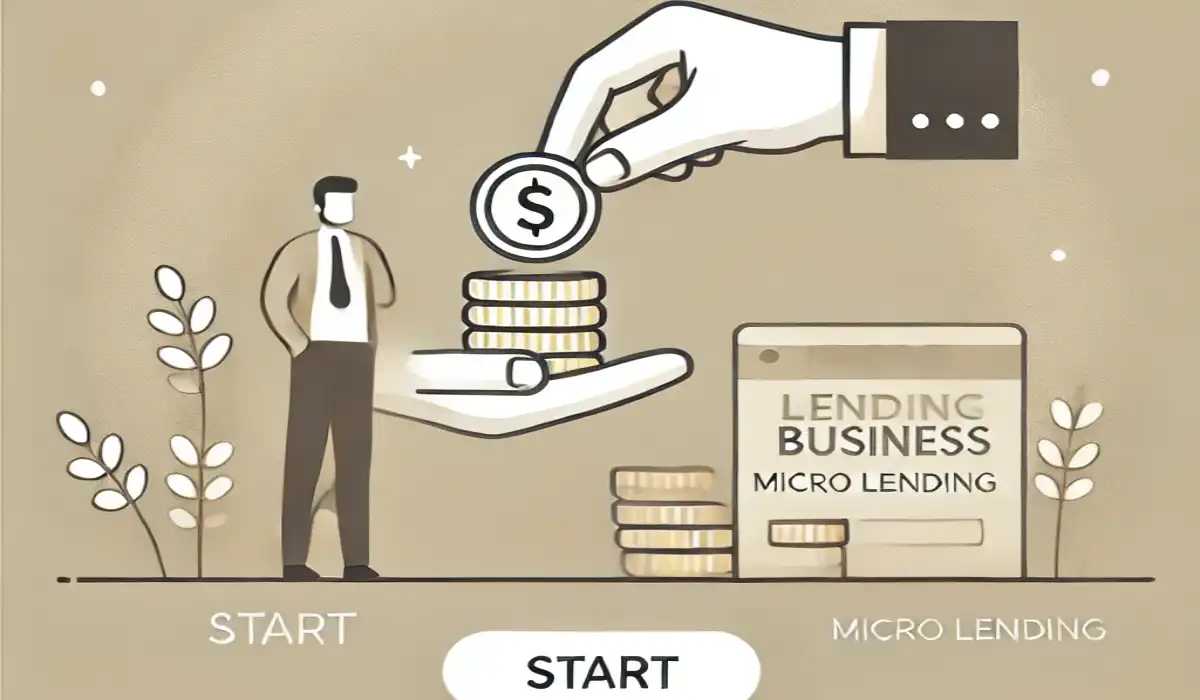Discover the essential steps on How to Start Micro Lending Business, including legal requirements, funding options, and tips for building a successful microloan program to support small businesses.
Understanding the Micro Lending Industry
What is Micro Lending?
Micro lending is a way of providing small loans to individuals or small businesses who often don’t qualify for traditional loans from big banks. Many potential borrowers, such as young entrepreneurs, may lack the credit history required for conventional loans, making micro lending a valuable option for them. Many people who need these loans are small business owners, startups, or individuals in underserved areas who struggle to get financial support. Micro lending can help them start a new business, expand an existing one, or handle an unexpected expense.
By giving small loans, micro lending supports entrepreneurship and boosts economic growth, especially in communities that are often overlooked. A micro lending business can be a rewarding opportunity, both financially and personally, for those who know how the conventional loan industry works.

The Growing Demand for Microlending Services
The demand for microlending services is on the rise, driven by the growing need for alternative financing options among small businesses and individuals. As traditional banks tighten their lending criteria, many entrepreneurs and small business owners find it challenging to secure the capital they need. This gap in the market creates a significant opportunity for microlending businesses to step in and provide much-needed financial support.

- Amount = $5,000 to $500,000
- Loan Term = 4 to 24 months
- Interest Rate = 1.11%
4.8
editorial team. We score based on factors
that are helpful for consumers, such as
how it affects credit scores, the rates and
fees charged, the customer experience,
and responsible lending practices.
- Min. Amount = $10,000
- Max Amount = $500,000
- APR = Factor rate starting at 1.11%
4.8
editorial team. We score based on factors
that are helpful for consumers, such as
how it affects credit scores, the rates and
fees charged, the customer experience,
and responsible lending practices.
Best for large business loans

- Loan Amount = $25,000 - $3,000,000
- $10,000 in Monthly Rev
- No minimum credit score requirement
4.9
editorial team. We score based on factors
that are helpful for consumers, such as
how it affects credit scores, the rates and
fees charged, the customer experience,
and responsible lending practices.
Best for large business loans

- Min Amount = $5,000 - 1,500,000
- APR range Not disclosed
- Minimum Credit Score 570
4.7
editorial team. We score based on factors
that are helpful for consumers, such as
how it affects credit scores, the rates and
fees charged, the customer experience,
and responsible lending practices.
Best for Small business loans

- Min Credit Score = 620
- Loan Amount = $10K-$5M
- Term = 6 months - 10 years
- APR = Variable
4.8
editorial team. We score based on factors
that are helpful for consumers, such as
how it affects credit scores, the rates and
fees charged, the customer experience,
and responsible lending practices.

- Check Your Eligibility
- Get $10K to $2M
- 24/7 Support
4.8
editorial team. We score based on factors
that are helpful for consumers, such as
how it affects credit scores, the rates and
fees charged, the customer experience,
and responsible lending practices.

- Amount = $10,000 to $1,000,000
- Factor Rate = Starting at 1.24
- Term = 2 to 12 months
4.7
editorial team. We score based on factors
that are helpful for consumers, such as
how it affects credit scores, the rates and
fees charged, the customer experience,
and responsible lending practices.
Microlending not only helps small businesses get off the ground but also plays a crucial role in stimulating economic growth. By providing access to capital, microlenders enable entrepreneurs to start new ventures, expand existing businesses, and create jobs within their communities. This ripple effect can lead to increased economic activity and improved living standards, particularly in underserved areas of developing countries.
As the economy continues to evolve, the demand for microlending services is expected to increase. This makes it an attractive business venture for those looking to start a lending business. By tapping into this growing market, you can build a profitable and impactful micro lending business that supports small businesses and drives economic development.
Benefits of Starting a Micro Lending Business
Running a micro lending business comes with several benefits. Interest rates vary widely, which can impact the profitability of the micro lending business. First, it helps people who might not have access to regular loans. Micro lending also allows you to make a profit from interest rates that can be extremely high interest rates vary based on the borrower’s needs and circumstances. Apart from profits, many people find personal satisfaction in helping others reach their financial goals and supporting community development.
Identifying Your Target Market
Who is Your Target Market?
The main target for micro lending businesses is individuals and small business owners who have trouble getting funds from large financial institutions. These type of collateral may be entrepreneurs, people from communities that lack financial resources, or small business owners looking to grow their business.
Identifying and understanding your target market is essential because it will help you plan better. You’ll need to know who is likely to benefit from your loans so that you can build a business that meets their needs. Learning from other business owners can provide valuable insights and advice on starting and growing your business.

Market Research and Analysis
To understand your target market, you need to conduct thorough research and market analysis. Market research helps you figure out the needs of your potential clients, understand the competitive landscape, and find opportunities to make your business unique. You’ll need to look at your competition and any risks that might affect your business. Market research will also give you insights into trends in the industry, which will be valuable as you build your business.
How to Start Micro Lending Business
Creating a Business Plan
Developing a Comprehensive Business Plan
A business plan is the foundation of a successful micro-lending business. It should outline how your business will operate, including who your target customers are, how you plan to reach them, and the amount of money you need to get started.
Including business insurance in your plan is crucial to protect against financial risks. The plan should also detail your revenue goals ongoing expenses, projected expenses, and the team that will help manage the business. A solid business plan will serve as a roadmap, guiding you as you grow and adjust your business over time.
Choosing the Right Lending Model
There are several ways to structure a micro lending business. For-profit businesses typically charge customers higher interest payments and rates compared to non-profit entities. Some of the most popular lending models include:
- Peer-to-Peer Lending: Connecting people who need loans with individuals willing to lend money.
- Balance Sheet Lending: Lending money directly from your business’s funds, which means taking on the risk and potential profit.
- Marketplace Lending: A combination of the two, where you connect borrowers with lenders but also lend from your own business funds.
Choosing the right model depends on your business goals, target customers, and risk tolerance. It’s important to weigh the benefits, costs involved and challenges of each model to find the one that suits your business.
Regulatory Compliance and Licensing
Starting a microlending business requires compliance with various regulations and licensing requirements. It is essential to understand the regulatory framework and obtain the necessary licenses and permits to operate a microlending business.
Maintain Regulatory Compliance
Maintaining regulatory compliance is crucial for a microlending business. This involves adhering to state and federal regulations, such as the Truth in Lending Act (TILA) and the Equal Credit Opportunity Act (ECOA). These laws are designed to protect consumers by ensuring transparency and fairness in lending practices.
Microlenders must also comply with state-specific regulations, which can include licensing requirements and interest rate caps. Failure by micro lenders to comply with these regulations can result in costly fines and penalties, damaging the business’s reputation and financial stability.
To stay compliant, it’s important to stay informed about any changes in the regulatory landscape. Regularly review your business practices and policies to ensure they align with current laws. Consulting with a legal expert who specializes in financial regulations can also help you navigate the complexities of compliance and avoid potential pitfalls.

Obtain Necessary Licenses and Permits
Obtaining the necessary licenses and permits is essential for a microlending business. This includes obtaining a business license, registering with the state’s business records, and obtaining any required federal licenses. Depending on your location, you may also need to secure state-specific licenses, such as a money transmitter license or a consumer lending license.
The process of obtaining these licenses can vary widely depending on your business name and state’s requirements. It’s important to research the specific regulations in your area and ensure you meet all the necessary criteria. This might involve submitting detailed business plans, financial statements, and background checks. While the process can be time-consuming, securing the proper licenses is crucial for operating legally and building trust with your clients.

- Amount = $5,000 to $500,000
- Loan Term = 4 to 24 months
- Interest Rate = 1.11%
4.8
editorial team. We score based on factors
that are helpful for consumers, such as
how it affects credit scores, the rates and
fees charged, the customer experience,
and responsible lending practices.
- Min. Amount = $10,000
- Max Amount = $500,000
- APR = Factor rate starting at 1.11%
4.8
editorial team. We score based on factors
that are helpful for consumers, such as
how it affects credit scores, the rates and
fees charged, the customer experience,
and responsible lending practices.
Best for large business loans

- Loan Amount = $25,000 - $3,000,000
- $10,000 in Monthly Rev
- No minimum credit score requirement
4.9
editorial team. We score based on factors
that are helpful for consumers, such as
how it affects credit scores, the rates and
fees charged, the customer experience,
and responsible lending practices.
Best for large business loans

- Min Amount = $5,000 - 1,500,000
- APR range Not disclosed
- Minimum Credit Score 570
4.7
editorial team. We score based on factors
that are helpful for consumers, such as
how it affects credit scores, the rates and
fees charged, the customer experience,
and responsible lending practices.
Best for Small business loans

- Min Credit Score = 620
- Loan Amount = $10K-$5M
- Term = 6 months - 10 years
- APR = Variable
4.8
editorial team. We score based on factors
that are helpful for consumers, such as
how it affects credit scores, the rates and
fees charged, the customer experience,
and responsible lending practices.

- Check Your Eligibility
- Get $10K to $2M
- 24/7 Support
4.8
editorial team. We score based on factors
that are helpful for consumers, such as
how it affects credit scores, the rates and
fees charged, the customer experience,
and responsible lending practices.

- Amount = $10,000 to $1,000,000
- Factor Rate = Starting at 1.24
- Term = 2 to 12 months
4.7
editorial team. We score based on factors
that are helpful for consumers, such as
how it affects credit scores, the rates and
fees charged, the customer experience,
and responsible lending practices.
Setting Up the Business
Forming a Legal Entity
Creating a legal entity for your business, such as a limited liability company (LLC) or corporation, is essential. This setup protects your personal assets, as it separates your business assets from your personal ones. If the business faces financial difficulties, this separation can protect you from personal liability. Consulting with a lawyer or accountant can help you decide which legal entity is best for your business.
Registering the Business
After deciding on a legal structure, you’ll need to officially register your business with the state. When starting a money lending business, it is crucial to understand and adhere to various legal and regulatory requirements. You’ll also need to obtain any necessary licenses and permits that your local or state government requires for a micro lending business. Additionally, it’s beneficial to register with the Small Business Administration (SBA) and apply for an Employer Identification Number (EIN) from the IRS. These steps help establish your business’s credibility and give it a clear legal identity.
Set Up Your Accounting System
Setting up an accounting system is essential for a microlending business. This involves tracking income and expenses, managing loan transactions, and maintaining accurate financial records. A well-organized accounting system helps microlenders make informed decisions, manage risk, and ensure compliance with regulatory requirements.
Related: Startup Business Loans for Bad Credit Guaranteed
Investing in accounting software can streamline this process and provide valuable insights into your business’s own financial performance and health. It’s also recommended to hire an accountant or bookkeeper to set up and manage the accounting system. They can help you establish best practices for financial management and ensure that your records are accurate and up-to-date. By maintaining a robust accounting system, you can better manage your cash flow, plan for future growth, and ensure the long-term success of your micro lending business.
Securing Funding and Capital
Funding Options for Micro Lending Businesses
One of the first steps to launching a micro lending business is securing the capital needed to provide loans. Starting a personal loan business involves understanding local laws, securing sufficient working capital first, and managing the borrower’s income and payments. There are several funding options to consider, including:
- Loans: Some lenders or banks may offer loans specifically for small businesses.
- Grants: Some organizations and government programs offer grants for new or small businesses.
- Investors: Finding investors who are interested in supporting your business idea can also be a good option.
Each funding source has its advantages and limitations, so you’ll need to choose the one that aligns best with your business goals and financial situation.
Managing Cash Flow and Capital
Careful cash flow management is essential for a successful micro lending business. You should create a financial plan that estimates your expected revenue, expenses, and cash flow. Regularly tracking your business’s cash flow helps ensure you have enough capital on hand to provide loans, pay for business operations, and save for future growth. Good cash flow management will also enable you to make informed decisions that keep your business financially healthy.
Building and Growing the Business
Setting Up Operations and Systems
For a micro lending business to run smoothly, you need well-organized systems. This might include:
- Loan Application Process: Design a clear and straightforward application process so that potential borrowers can easily apply for a loan.
- Credit Scoring System: Develop a system to assess the creditworthiness of each applicant.
- Repayment Process: Set up a reliable system to manage loan repayments, which can include reminders or online payment options.
Establishing these systems early on will help your business run efficiently and provide a positive experience for your customers.
Launching and Scaling the Business
Launching the Business
Launching your micro lending business involves promoting your services and attracting your first customers. A well-thought-out marketing plan is a few important topics to introduce your business to the market. You can use various strategies like social media marketing, online advertising, and local community outreach. Setting up a budget for your marketing efforts and choosing the right channels to reach your target customers will make your launch more successful.
Related: Micro Loan for Bad Credit: Your Path to Financial Support
Scaling the Business
After establishing your business, the next step is to plan for growth. This includes setting realistic goals for expanding your customer base, increasing revenue, and enhancing your services. You’ll also need to review and adjust your marketing strategy and consider investing in technology that can help streamline your operations as you grow. Scaling your business helps ensure that you’re able to serve more customers and achieve long-term success.
Conclusion
Starting a Successful Micro Lending Business
Launching a micro lending business requires thorough planning and careful decision-making. You need to understand the micro lending industry, identify your target market, conduct business due, and create a comprehensive business plan. After setting up your business structure and securing funding, it’s important to establish efficient operations and systems to manage loans and cash flow effectively.
With the right approach, your micro lending business can become both profitable and impactful, helping individuals and small businesses in need of financial assistance while providing you with a fulfilling venture.

- Amount = $5,000 to $500,000
- Loan Term = 4 to 24 months
- Interest Rate = 1.11%
4.8
editorial team. We score based on factors
that are helpful for consumers, such as
how it affects credit scores, the rates and
fees charged, the customer experience,
and responsible lending practices.
- Min. Amount = $10,000
- Max Amount = $500,000
- APR = Factor rate starting at 1.11%
4.8
editorial team. We score based on factors
that are helpful for consumers, such as
how it affects credit scores, the rates and
fees charged, the customer experience,
and responsible lending practices.
Best for large business loans

- Loan Amount = $25,000 - $3,000,000
- $10,000 in Monthly Rev
- No minimum credit score requirement
4.9
editorial team. We score based on factors
that are helpful for consumers, such as
how it affects credit scores, the rates and
fees charged, the customer experience,
and responsible lending practices.
Best for large business loans

- Min Amount = $5,000 - 1,500,000
- APR range Not disclosed
- Minimum Credit Score 570
4.7
editorial team. We score based on factors
that are helpful for consumers, such as
how it affects credit scores, the rates and
fees charged, the customer experience,
and responsible lending practices.
Best for Small business loans

- Min Credit Score = 620
- Loan Amount = $10K-$5M
- Term = 6 months - 10 years
- APR = Variable
4.8
editorial team. We score based on factors
that are helpful for consumers, such as
how it affects credit scores, the rates and
fees charged, the customer experience,
and responsible lending practices.

- Check Your Eligibility
- Get $10K to $2M
- 24/7 Support
4.8
editorial team. We score based on factors
that are helpful for consumers, such as
how it affects credit scores, the rates and
fees charged, the customer experience,
and responsible lending practices.

- Amount = $10,000 to $1,000,000
- Factor Rate = Starting at 1.24
- Term = 2 to 12 months
4.7
editorial team. We score based on factors
that are helpful for consumers, such as
how it affects credit scores, the rates and
fees charged, the customer experience,
and responsible lending practices.


 Read More
Read More 




